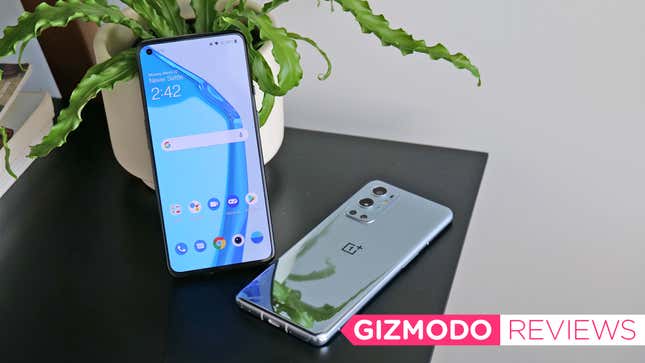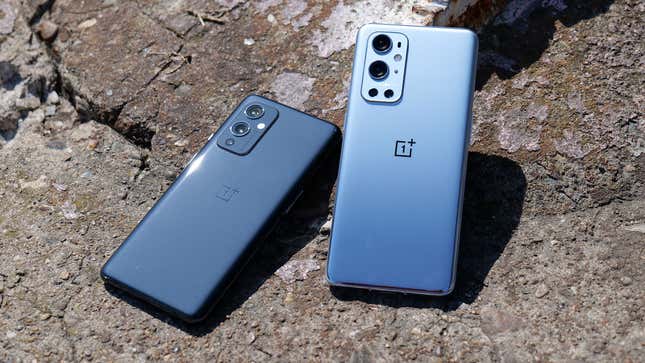
Last fall’s OnePlus 8T was a solid device, but it still seemed like OnePlus could step it up. With the release of two new flagship phones, it looks like OnePlus agreed. The new $730 OnePlus 9 and $970 OnePlus 9 Pro sport noticeably improved cameras due to a new partnership with Hasselblad, even faster charging, including wireless charging on both models, and a top-to-bottom spec refresh featuring speedy new components.
Editor’s Note: Post launch, OnePlus has confirmed that unlocked OnePlus 9 phones are certified to work on T-Mobile and Verizon’s 5G network, although there still isn’t support for AT&T 5G.
Make no mistake: Not only are the OP9 and OP9 Pro the best phones OnePlus has ever made, but the company has also gone all New Game+ on us and entered a second phase of life. In its early days, OnePlus catered to the desires of hardcore phone enthusiasts, but the company has since evolved and entered the mainstream. I have to admit: OnePlus has made great strides with its new devices. But a part of me still wonders if it’s really enough.
For me, one of the biggest disappointments about the OnePlus 9 and OnePlus 9 Pro is their design, because even though they are both solidly built, they don’t have much in the way of personality. Honestly, if it wasn’t for the various logos scattered around in back, I’m willing to bet that even the most tech-savvy folks would have a hard time differentiating the new OP9 lineup from last year’s Samsung Galaxy S20+. Both phone lines feature similarly rounded designs with curvy sides, and a rectangular camera module in the top right.
Aside from OnePlus’s signature Alert Slider, the only detail that really sets the OP9 apart from the S20 lineup is the color options, and while I do like the gradient OnePlus uses on its Morning Mist model, a paint job is only skin-deep. OnePlus even opted for a flatter screen on the standard OP9 along with a plastic polymer back, which are both moves Samsung has made in recent years, while opting for a curvier panel on the OP9 Pro with sloping edges, just like you get on an S20+.

The similarities don’t stop there, either. Like Samsung, the OnePlus has added a 120Hz refresh rate to the OP9's 6.55-inch screen, with the the OP9 Pro getting a 6.7-inch Samsung-made panel with a variable 120Hz refresh rate that can dynamically adjust its display to match the kind of content you’re viewing. That means higher refresh rates while gaming to deliver smooth visuals, and lower refresh rates while surfing the web or looking at pictures to help save on battery life.
Now I don’t mean to be too harsh, because if you’re gonna crib off of someone else’s notes, you might as well pick the world’s biggest smartphone maker. And if you ignore the competition, the OP9 and OP9 Pro’s displays are great in their own right, offering strong brightness (upwards of 800 nits in our testing), and the rich saturated colors people have come to expect from high-quality AMOLED displays. I just wish OnePlus would inject some of its own style or unique details to make the OP9 line stand out on its own.
The base model sports a a Snapdragon 888 chip, 8GB of RAM, and 128GB of storage (with a boost to 12GB/256GB available as well), making the OP9 phones are as powerful as ever. Both the OP9 and OP9 Pro routinely rivaled or posted slightly higher benchmark scores than what we’ve seen from similarly specced Samsung phones. And thanks to little touches like the faster animations in OnePlus’ Oxygen OS (which is based on Android 11), the OP9 and OP9 Pro often feel even more responsive than you might expect. When it comes to speed, OnePlus delivers.

OnePlus also includes a number of standard features found on other premium phones, including stereo speakers, an in-display fingerprint sensor, water resistance, and 5G, but unfortunately support for some of those features varies greatly depending on where you buy it. On T-Mobile (which is the only U.S. carrier that will carry the OP9 line at retail), you get full 5G connectivity and an IP68 rating for dust and water resistance. However, if you get a OP9 or OP9 Pro unlocked, you don’t get the same rugged credentials and you won’t be able to access 5G on AT&T, which is a huge bummer for people who might want to bring their own device to another network. And if I’m really nitpicking, I feel like the OnePlus optical fingerprint sensor isn’t quite as fast or accurate as the ultrasonic reader that Samsung uses on the Galaxy S21.
But let’s get down to the biggest upgrades on the OP9 line: the camera performance. OnePlus just inked a 3-year deal to collaborate with Hasselblad, and to start, OnePlus has employed Hasselblad to overhaul its camera app with a new UI and easier ways to adjust settings and edit photos. Additionally, OnePlus also leaned on its new partnership to create Natural Color Calibration with Hasselblad that uses both improved algorithms and hand tuning from experts at Hasselblad to capture more accurate hues and finer details. And I have to say, the results are quite impressive.

For years, the image quality of OnePlus phones was always a tier below competing phones from Apple, Samsung, or Google. But that changes on the OP9. Colors are rich and deep, subjects are sharp, and I personally really like the high-contrast look Hasselblad’s tuning has given OnePlus’ photos, even if it doesn’t always result in the most realistic looking image.
The standard OP9 features a 48-MP main cam, 50-MP ultra-wide cam (with a huge IMX 766 sensor), and 2-MP monochrome cam to help out with color accuracy. The OP9 Pro features a 48-MP main cam with an even newer Sony IMX789 sensor, the same 50-MP ultra-wide cam used on the OP9, a 3x telephoto zoom cam, and the same handy 2-MP monochrome cam. But regardless of which phone you choose, either one can totally hang with other high-end handsets.

In a photo I captured of some tulips, the regular OP9 captured strong dynamic range and good details, even on the inside of the flower. And at night, OnePlus’ improved Nightscape mode kept up with Samsung’s dedicated low-light mode, with the OnePlus 9 Pro even capturing a sharper looking (possibly a bit over-sharpened) photo when zoomed in 3x compared to the Galaxy S21. Even ultra-wide shots from the OP9 and OP9 Pro largely lived up to OnePlus’ claims that its new “free-form” lens helps cut down on the barrel distortion you typically see in wide-angle photos.
However, like I said before, while I appreciate Hasselblad’s fine tuning, I have to admit that in a shot of plant-based nuggets (don’t ask), the OP9 did boost contrast a bit too much, which resulted in deeper shadows than what I actually saw. But still, OnePlus’ image quality has taken a big step forward, and with Hasselblad expected to add new custom hardware to future phones, OnePlus’ photography cred is definitely getting a big boost.
Finally, when it comes to battery life, both phones performed rather well, with the standard OP9 and OP9 Pro lasting 15 hours and 35 minutes and 13 hours and 54 minutes, respectively. That’s both well above the current 12:25 smartphone average and standard S21's time of 12:36, and in the same range as the iPhone 12 (14:20). When it comes to charging, the OP9 and OP9 Pro are incredibly fast, offering 65-watt wired charging that can legit recharge the phone from dead to 100% in around half an hour. In my testing, starting at 5%, the standard OP9 was able to hit 72% charge in 15 minutes and hit 100% before the full 30 minutes were even up. And as an added bonus, when you want to charge other non-OnePlus devices, you won’t get a full 65 watts of power, but you can still charge over USB-C at up to 45 watts, which is handy if you only want to carry a single power brick around.
Of course, wired charging is a bit old-school, so in addition to giving the standard OP9 15-watt Qi wireless charging, OnePlus also made a proprietary $70 charging pad that can deliver 50 watts of wireless power to the OP9 Pro, which was enough to take the phone from 5% to 74% in 30 minutes. In short, this is the fastest wireless charging you can get on any phone available in the U.S. right now.
OK, great—but should you get one? The tricky part is that the answer to that question depends greatly on your carrier and how much you care about or have access to 5G. For people on T-Mobile, the OP9 and OP9 Pro are basically slightly discounted versions of the S21 and S21+, and if you’re willing to BYOD, Verizon customers have similar value proposition. You get the same processor and similar base components, with new and improved image quality, and a lot of premium features like water resistance, wireless charging, and high refresh rate screens. However, for people on other networks, the equation isn’t quite as clear, most notably because you not get support for 5G depending on your carrier.

And this is kind of the problem for OnePlus, because the company has obviously leveled up in many areas. OnePlus’ collaboration with Hasselblad is already paying off, and with LG’s smartphone division struggling and Google doing its own thing, OnePlus is filling in for other Android phone makers by creating a worthy alternative to Samsung’s flagships.
But forgoing support for 5G on one of the nation’s three largest carriers, skipping IP68 certification on unlocked models, and a lackluster design means that OnePlus 9 and OnePlus 9 Pro stop just short of being true contenders. They’re great phones and a good value for money, but they just don’t have the X-factor you need to turn a solid device into something you love.
[Update: 3/31 at 5:30 PM] Updated the review with new info regarding 5G support for unlocked OnePlus 9 phones on T-Mobile and Verizon.
README
- The main differences between the OP9 and OP9 Pro are that the OP9 doesn’t have a VRR screen, its display is lower resolution (2400 x 1080 vs 3216 x 1440), it has slower 15-watt wireless charging, no telephoto camera, and a plastic back instead of glass.
- OnePlus has added 65-watt wired charging to both the OP9 and OP9 Pro, and it’s seriously quick. And new for 2021 is 50-watt wireless charging on the OP9 Pro (the OP9 has slower 15-watt wireless charging).
- Right now, support for 5G is only available on T-Mobile’s network, even for unlocked models.
- OnePlus says the OP9 will receive two major Android updates and three years of security patches.
- It’s a minor thing, but I’ve found the OP9's haptics motor is a bit on the weak side.
- The OP9 Pro on T-Mobile will start at $1,068 because T-Mobile is selling the higher-specced config with 12GB RAM and 256GB of storage.